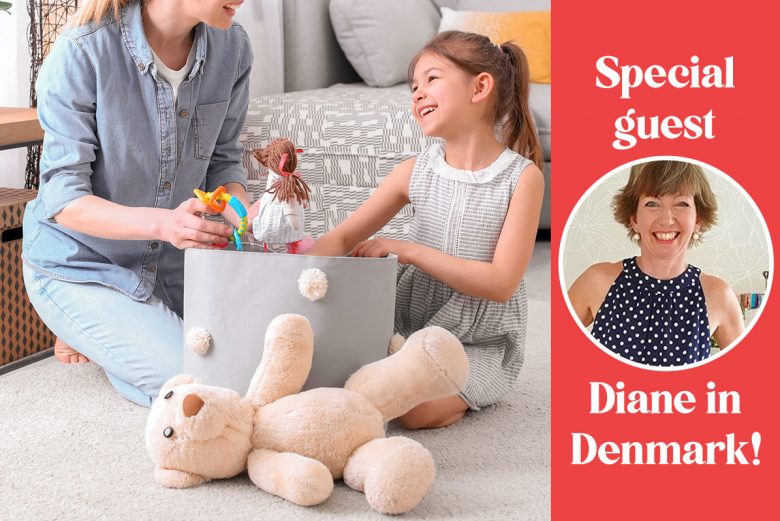
A breath of fresh air to make your home happier.
Kids, meals, work, laundry, homework, chores… Does it ever start to feel like way too much to manage? And you’ll never quite get on top of it?
In this episode, Carol and Anne are joined by Diane in Denmark for some family-saving tips to make life smoother. Her top 3 tips give you time to relax more in the evening and prioritize what matters most to your family.
This episode’s Parenting Practice
Try one of the tips in this week’s episode! Like Diane says, don’t try to do it all at once. By introducing one new idea at a time, you teach your family a routine that you can build on.
Transcript of podcast episode
Carol: Welcome to The Child Whisperer Podcast. I’m your host, Carol Tuttle. Author of the best-selling parenting book, The Child Whisperer. I’m with my co-host, Anne Tuttle Brown. We are so excited to have one of our favorite people in the world on today who is also known on YouTube, Instagram as a routine coach and life coach and mentor. We are so excited to learn some valuable insights and her top three organization tips that are going to make your life run smoother. Welcome, Diane in Denmark.
Diane: Oh, thank you, Carol.
Carol: It’s great to have you. And those of you that are members of our Dressing Your Truth community, you’ve met Diane through our groups. And many of you follow her on YouTube. And if you go check her out on YouTube, because whether you need organization support or not, she’s guaranteed to put a smile on your face. She is a Type 1 in my Energy Profiling system. And she’s just… Your attitude’s phenomenal.
Diane: Sure. Thanks, Carol.
Carol: I bet you’ve heard this a lot this year as well as we’re recording this in early January in 2021. I bet you’ve had a lot of your fans and followers thank you for how you’ve maintained through a challenging year prior to this, such a great attitude.
Diane: Yeah, I’ve had a lot of comments about, you know, the usual thing of breath of fresh air, being a lighthouse in the dark moments. So that’s been very, very encouraging.
Carol: Yeah, so beyond even the organization tips, she’s emotionally uplifting.
Diane: Thanks. Thank you for that. Yeah.
Carol: And as usual, Anne is with me and joining as my co-host today, which is great. She has a lot of thoughts to share as well because she is in…many of you know this is why I brought Anne into the podcast more recently is because she’s in the trenches with the kids.
Anne: The trenches.
Carol: I’m the veteran parent.
Anne: I like to call it on the playground. I’m on the playground.
Carol: You’re right in it.
Anne: But I will say, even if you don’t think you need routine tips, still go follow Diane because she will say something that will inspire you. Because I’m someone who thrives on routines and I have just naturally drawn to that. But listening to Diane and what she has to share has taken it to another level. So thank you, Diane. We’re glad to have you here.
Diane: You’re very welcome. And actually, I love the podcast. I actually listen to when I’m doing my routines. It’s just the right length of time and…
Carol: Yeah, you learn a lot about the Energy Types from a perspective of looking it through a child’s life.
Diane: Yeah, I learn a lot while I’m getting things done. And that is perfect for when you’re cleaning.
Carol: Well, let’s get right into these three tips. Share your first one that you feel as if… These will be applicable to any Type and these are really for parents. So this is for your benefit. No matter your Type, these are going to be a benefit to you.
Diane: Okay. So, the first one is to make sure that you have a daily routine. And something very, very simple, where we’re not making long lists here. But a daily routine one for school nights, you know, Monday to…sorry, Sunday to Thursday, and then one for the weekend so that everybody knows what’s expected of them. And it just sets us up for a good day.
Carol: So I think this is important, your routine for the next day doesn’t start in the morning, it starts the night before.
Diane: The night before. Exactly. So there’s no kind of grumpy mornings, you know where everything is, you’ve got everything set up. And it doesn’t take any more time because you’re doing the same things. You’re just moving it up in your schedule. And that’s going to take away a lot of the stress. And that’s where parents really feel the stress is in those busy mornings.
Carol: So what are some of the few things you would pay attention to the night before that sets you up for success the next morning?
Diane: Especially for the kids knowing what is coming up to them the next day. Do they need sports equipment? Where’s that assignment? Do they have papers to be signed? Where’s the school bag? Yesterday’s packed lunch, is it lurking at the bottom? And even things like you know, laying out clothes for the next day if you have a child that’s kind of very, very slow in the morning. All those kind of things are going to help them and make it less stressful for mom and dad too.
Carol: Breakfast too, how do you prep for that?
Diane: Well, normally we set the breakfast table in the evening. Since we’ve had dinner, we reset the table for breakfast.
Carol: Those are things you’d have children do as well.
Diane: Yeah, exactly.
Carol: Those could be their assignments, not the parents are doing all that.
Diane: No, no, no. Oh, no, no, no. This should be the kids. I mean, they know what they’re having for breakfast. And it also ensures that everybody is actually eating breakfast because it’s all set up and ready to go.
Carol: Right? What about you? Do you do this, Anne?
Anne: Yes. I find when I do, it’s more successful.
Diane: Yeah, it’s the follow-through. It’s actually just taking that five minutes when you’re cleared after dinner.
Anne: Yes. Sometimes you can get so consumed with what’s going now or, you know, the dishes that need to be cleaned up for dinner or, okay, everybody, we just need to go to bed now. Like the day is done, let’s move to bedtime. And then, you know, you’re just doing your own thing as a parent once the kids have gone to bed. Once I’m headed up the stairs, I’m like, “Oh, shoo, I gotta get ready for this, and this, and this tomorrow.” And if I throw it to the morning, then I will be much more rushed and frantic. And so, making it part of your routine. And you’ve said something in another video at an event we heard you said, “Don’t do it, like, at bedtime. Do it at dinnertime. Move your routine for the next day earlier in the day so that you can then have time to relax and you’re not getting all these to-dos done.”
Carol: We are not as tired, either.
Diane: Yeah, exactly. You need to make it… We have a routine and a rule here in the family, nobody gets to leave the dinner table until…they can leave the dinner table, but they’ve got to come back and help clean up. You know, everybody cleans off the kitchen counters, puts things back in the refrigerator, makes packed lunches for the next day. And that should really be the time for, you know, you can reset the breakfast table, everybody can have do a task. And that way, once that’s done, everybody gets to relax and really enjoy the evening. You know, you’ve got nothing hanging over your head.
Carol: Now, do you sit down for breakfast together? I mean, and I should mention for those of you who don’t know, Diane actually lives in Denmark, obviously Diane in Denmark. But I think somewhat, you’re better in your culture where I think in the United States, families are getting back to this of making it more strict effort to sit down together even for dinner, let alone breakfast.
Anne: I always like the breakfast table.
Carol: I know.
Anne: I mean, we’re all eating at the counter while the kids are, “I’m standing eating.”
Carol: I’m curious, do you all sit down at the breakfast table?
Diane: No, no, no, we don’t. But we all perhaps eat at different times. But just that very fact of having, you know, the plate there, the box of cereal, we pour it, it just means that when you come into the kitchen, it’s all set up. You’ve really not got an excuse not to eat. And that’s so fun with the kids also for Mom and Dad because you wouldn’t let your child go without breakfast. So why are you doing it to yourself? You know, you’re too busy doing other things. You really got to, you know, be good to yourself and eat.
Carol: Well, the prep, as you’re mentioning your daily prep starts the night before, it takes away the frenzy. That’s what I see the difference because there’s a lot of running around hurrying and trying to get a lot done. And it’s frantic and frenzied, and it’s not a great way to start your day.
Diane: Absolutely not. And it takes the same time. I mean, it takes the same time to bring out the breakfast bowls, fill as it would do the next morning, but the stress has gone down. And that’s the big takeaway I think for many people to discover, well you can have an enjoyable start to the day.
Carol: Well. you could even do with the outfit preps. Now, you’ll do several, but you know me, I’ll do like 10 at a time, you know. And you did that with Katie recently, Anne. You followed what I do, and Diane does this as well is we assemble the whole outfit from accessories to everything, and as you know, I hang them, and I have everything ready to go. It’s a grab and go outfit. Now you did several outfits with Katie.
Anne: And we rolled them up and put them in her drawer, so they were…
Carol: And they were ready to go.
Anne: Yeah, she really enjoyed that.
Carol: And she loved it so much. She told me, she said, “Grandma, Mom helped me put, what, half a dozen outfits together.” You could do that same idea to get ahead of it so it’s not the… That’s why I don’t want to have to do it every night. I do it in mass, spend a little more time, then I don’t have to think about it for about 10…
Anne: You know, my Type 3 Katie, she’s really thinking ahead. She doesn’t really prefer pajamas, and so she’ll wear her clothes for the next day.
Carol: I thought of that. Yeah.
Anne: And so, she’s already in her clothes when she goes to bed. She’s really…
Carol: I mean, most kids are wearing knit fabric, so let’s begin first.
Diane: There are lots of ways you can do it. You can do like the top drawer of their chest of drawers, that can be their next day drawer where they put all the things that they’re going to need for the next day, you know, whether it is sports equipment, you know, sports gear, their outfit. Or you can also have, you know, those kind of cubby holes, the hangers that you can put in your closet with, you know, the seven holes in them. You could do outfits Monday to Sunday. Actually, I have a client of mine where the kids were moving between the dad’s house and the parents were divorced. And the daughter was moving between the two houses. The mom could pack her outfits for the whole week in one of those, you know, cubby hole things and then concertina fold it down. And it just goes into that. And then when she gets to dad’s house, she just pops it in the closet and the outfits are ready to go. So lots of ways to do it.
Carol: Time to take a short break. Don’t worry, we’ll be right back after this.
Female Speaker: Knowing your Type and your child’s Type changes everything, doesn’t it? It helps you to understand one another better. It can help your outside too. When you wear clothes that express your Type, you feel better, you look better, and people understand you more easily, including your kids. Carol Tuttle created the Dressing Your Truth program to help you dress true to your Type and create a personal style that expresses who you really are. The best part, you can learn all the basics for free. Start loving how you look and feel at dressingyourtruth.com.
Anne: One thing I’ll do I’ll add is, you know, each child has different things that they need to get done throughout the day. And so, we’ve started calling…I’ve made a list for each child. Well, for Katie, she’s almost 9, Sam, he’s almost 5. Roy, he’s 3, so he doesn’t have too many must-dos is what we call them. So I make a list of Katie’s must-dos and I put piano, homework, whatever else is on there. And then it’s the get-to-dos. What do you get to do? Maybe you can watch a show, or we can…
Carol: Or once the must-dos are done, you get to do.
Anne: We get to have a friend over. And she’s been really motivated by, like… I actually got this idea from her teacher. They have a list in their class. So it’s really nice that she has that routine in school and also when she comes home now. And so they know they get to the list and they say, “Okay, I got to do these things.” And then they can look forward and say, “Okay, but after that, what do I get to do?”
Carol: That’s a really good insight right there to what is your child responding to that a teacher’s doing? Well, just duplicate it in your house. Yeah, that’s really great have. Let’s go to…
Anne: Yeah, I saw it on the board, and I was excited about that. And I’ve created must-dos for me too now, like what do I absolutely need to get done today? Because sometimes your list can just get really long. And so sorting out like what’s…
Carol: Do you have get-to-dos?
Anne: I should add that, yeah. We’ll talk about that when we get to the Type 2 organization tips. Diane had some good ideas.
Diane: Yeah. Well, we actually do that as well. We call them got-to-dos and want-to-dos.
Anne: Oh, that’s fun too.
Diane: You got to get got-to-dos and then you get to do your want-to-dos. So, same idea. Okay, shall we talk about the next point?
Carol: Yep.
Diane: Okay, a set of house rules. And again, don’t make these really complicated or long, but just kind of a set of house rules. And it will, of course, depend on your family, the age of your children. But perhaps you have ideas about eating together as a family, maybe you want to post a set of house rules on the kitchen on the fridge saying that, you know, house rules, wash hands before we eat. Everybody has to help once we have eaten. Make packed lunches before you leave the kitchen in the evening. You know, just keep them short. But just having the house rules where everybody’s on the same page means that the grown-up is not, you know, the bad guy here. That you come up with…and if possible, come up with these things together. It depends how much you want to go into the house rules thing. Perhaps inside the whole cupboard you have a listing. You know, as soon as you come in the door, you hang up your backpack, put your shoes…
Carol: So, these are more…they’re not behavioral, they’re management.
Diane: No, they’re just management just so that everybody knows when you come in the door, you hang up your coat, you hang up your school bag, and, you know, wash hands. So, just keep it very, very simple.
Anne: You know, creating rules like this and family, the structure supports children so much. Otherwise, they’re looking for what do I do? Or why is mom asking me to do this now, but she didn’t ask me to do that last time?
Diane: Yeah. And you’ll find that if you have like a Type 4 child, as I do, they will point out if the others aren’t doing it, you know. So, you know, if you’re a Type 1 mom, you don’t even need to say anything because the house rules are there and people will just, you know, hopefully, follow. But, you know, try to put together the house rules as a fan.
Anne: I like that, I’m thinking it’s an idea together.
Diane: And I think, Anne, you were in of the podcasts I listened to Child Whisperer, you’re actually talking about that where you had gone through with your children, you know, what was reasonable and, you know, work on these together. Suddenly mom’s been listening to the Child Whisperer Podcast and this is the way it’s gonna be. You know, involve the family in it.
Anne: Yeah, I like that idea a lot. Something recently where we’ve created more rules is around the times which we eat. And I read a book in the summer called “French Kids Eat Everything.” And it really inspired me to just, like, get more structured in the way we eat. And so, we have a designated breakfast time, lunchtime, snack time, and then dinnertime. And we, I mean, put a timer on and everybody sits at the dinner table for 30 minutes. And we have a routine that we go through at the dinner table. And it’s brought… And I had to drill it into my kids because it was so different than what they had done, especially since we were home so much in 2020. You know, it was kind of like the pantry was always open. And it was like we don’t need snack, more morning snack, we just had breakfast, we’re having lunch soon. And so…
Carol: Then we’ll get something to eat at mealtime.
Anne: Yes, yeah, it gets them to be hungry and to eat more, you know, solid food, like…
Carol: Right, balance.
Anne: …more nutritious. And so, I can just speak to how that has really benefited our family implementing those rules and guidelines, even though it took some definite learning and getting out of our old habits. And it’s been helpful for me as well.
Carol: When you implemented family style, you put all of your food on the table.
Anne: I was a short-order chef before, I was standing behind the counter, you know. And so, everybody had gotten served and then I would sit down, then everybody would get up and I’m still eating.
Carol: The interesting fact in that was she has three Type 3 family members. Type 3s eat faster than Type 2s. And all of a sudden, the 3s would be out of there in 10 minutes, and hence…
Anne: And my Type 2 eats very little, so…
Carol: Yeah. Then they Type 2 has a very limited palette and he gets done quickly for that reason. And so, by the time Anne would sit down, they’d all be done.
Diane: That’s why we say…
Carol: She’s eating by herself.
Anne: Like I just spent an hour getting this meal ready and all you people are gone. I was so bothered. So anyway, I think that’s probably a good place to start with. Where do you need the rules? Where are you experiencing the most frustration in your day-to-day routines?
Carol: Start with the pain points.
Anne: Okay, like, let’s focus on eating. Let’s focus on getting out the door. Why is that taking so long? What rules can be implemented? Sit down with the family and say this is the problem, what are some ideas? And lead that conversation out with your ideas.
Carol: So start with your highest pain points, not with everything. And start to get that going and then go to the next so that you’re not…
Diane: Yeah, and with all these things, just don’t force it down everybody’s throat because they’re going to…they’re going to quickly think, “Oh, Mom has gone off. You know, she’s going crazy with all these routines and things.” Just do it generally. And if it doesn’t work, change up. You know, see what’s working, what doesn’t work.
Anne: Yeah. And point out what is working and how they’re benefiting. That’s something that my kids have really enjoyed our family dinners and what we do together now and the conversations that we have. And so it’s like, “Look at how much better we’re doing. Do you enjoy this?” and point out the successes that you are experiencing by following those rules and you can use that the next time you create a set of rules.
Carol: You also have an interactive conversation; you’ve added a conversational setup.
Anne: Yeah, we could do a whole podcast on family dinners. That might be fun.
Carol: I know. You’ve added more to it than what we will say. You’ll have to listen. Hey, number three.
Diane: Number three is to declutter on a regular basis. So too much stuff and, you know, we’re talking about all the kind of things that kids accumulate, whether that’s toys, games, sports gear, school journals, artwork, it’s confusing for all the time. So you really have to help your children, teach them how to declutter. And we’ll talk about that and the different tips for each Energy Type. Because this is going to be an ongoing challenge for them to sort out what they need to keep, what is sentimental, sentimental things, and just make it a regular thing that, you know, things are coming in, they’re changing ages, things are going out. And, you know, just keep going with this because you know yourself, when the child is 2 years old, they have a lot of games and toys. And then 3 years old, they’re into something completely different. So they’re just changing and growing. So we’ve got to keep decluttering. Keep an eye on what is coming in and what is going out.
Carol: I love this. Because to me, this is the foundation of establishing your children can’t manage keep their space organized when there’s too much stuff. It’s overwhelming to them. And…
Diane: For all Types.
Carol: Yes, for all Types. I think it’s just children don’t naturally have these… These are learned skills, managing space and being tidy and organized is a skill set. It’s not a tendency that people are, I think, effortlessly born with. I think it’s acquired through modeling and acquired through teaching. But if you have too much stuff, it’s too much to ask of a child. We had a member of the Child Whisperer Facebook group post a photo of their Type 1 daughter’s room, and everybody said the number one thing she had to do was get rid of about 80% of it. There was so much stuff. Like, don’t even try. I mean, this is like…
Anne: I recently did that with Katie’s room.
Carol: Yeah, it’s like this is….
Anne: I mean, we’ve, you know…
Carol: Don’t expect that of your child.
Anne: She has a lot of stuff and she gets busy doing something, and then she move on to the next thing. So ends up being like a lot of papers that she’s created crafts with. But there was a place for everything and so we could tidy up her room, but I had just had the idea one day, I was like, “I just got to take out half of the stuff in her room.” And before every Christmas, I kind of like to do a toy purge and go through and, like, “What are they not playing with? What can we give away?” And so I was doing that, and that idea came I was like, “I gotta declutter her room.” And so some things I got rid of, gave to…
Carol: She’s old enough to have an opinion about it.
Anne: For this one, she wasn’t there. I just went for it. But I have…
Carol: Did she know you were gonna do it?
Anne: No. But I didn’t give everything away.
Diane: Okay. I’m gonna have to stick in there and say I think you should never ever declutter somebody else’s stuff. Okay? Because what is important to you, or what you think is important or has cost a lot of money is very different for the child.
Anne: But in my defense, I put it in a closet. So I did not give it away, because I did recognize. I was like…
Diane: No, that’s actually…
Anne: No, and I appreciate that.
Diane: …you know, before they run off from this podcast…
Carol: I know. I know.
Anne: No, I appreciate that. I’ve actually… And I have made my kids.
Diane: Remove it but we’re not taking away. But we’ve got some tips coming up for you on how to help your child declutter those.
Anne: And so, I have made my kids part of the process of we’ve gone through clothing, like, “Do you want to keep this, yes or no?” And we’ll make piles and then we can go back through and sort it out again. But yeah, I agree with you, Diane, having them part of the process, that’s part of the teaching.
Diane: And it’s a teaching. It’s a teaching. And they learn very quickly how to declutter and then it becomes easy. You know, you got to get them while they’re young.
Anne: Yeah, so going back, I probably should have made her part. She has lots of like jewelry boxes. So I put a lot of…like half of those in a box, put her stuffies in her closet, her dolls and things. And she came home and was like, “Wow, my room is so clean.” And I did, I was like, “Should I be doing this without her?” But I was in that moment of just wanting to get it done and wanting it to benefit me more in the moment. But it’s…
Diane: You gotta start somewhere.
Anne: In the end, her room has stayed a lot cleaner because she’s just had less stuff.
Carol: Declutter. These have been great and now we’re going to wrap this podcast up and we are moving into creating, producing a podcast, life and space organization tips for each of the 4 Types of children. So, look forward to those coming out for four more podcasts and we’re gonna get real specific about each Type, some of their most common challenges, and Diane’s tips when it comes to life and space organization. So thanks, Diane. These are great. They’re applicable to anyone. I’m going to encourage any adult would benefit from this, whether their children are raised, they have no children or not. These are all just great basic life management tips. So we’ll wrap this one up. Thanks, Anne and Diane. And we look forward to you listening in the future ones.
Diane: Okay. Thanks, Carol.
Carol: Thanks for listening. For more support, go to thechildwhisperer.com where you can purchase the book, subscribe to our weekly parenting practice email, and find the transcription and audio of “The Child Whisperer” podcast.
Anne: If you’re listening on iTunes, thank you for leaving a review. If you have a parenting question, please send it to [email protected].



